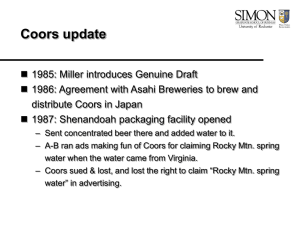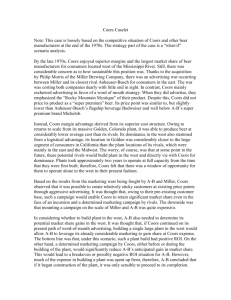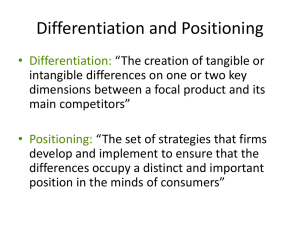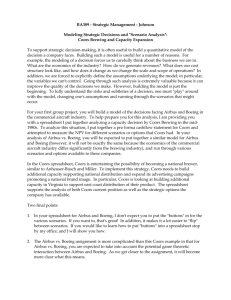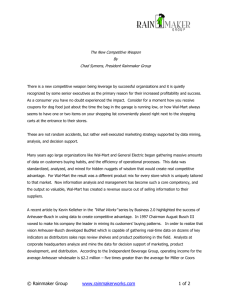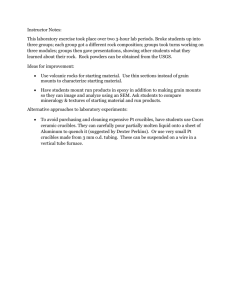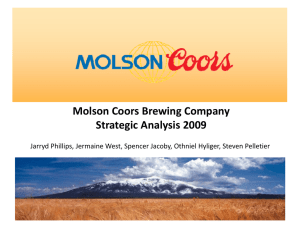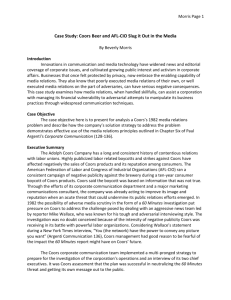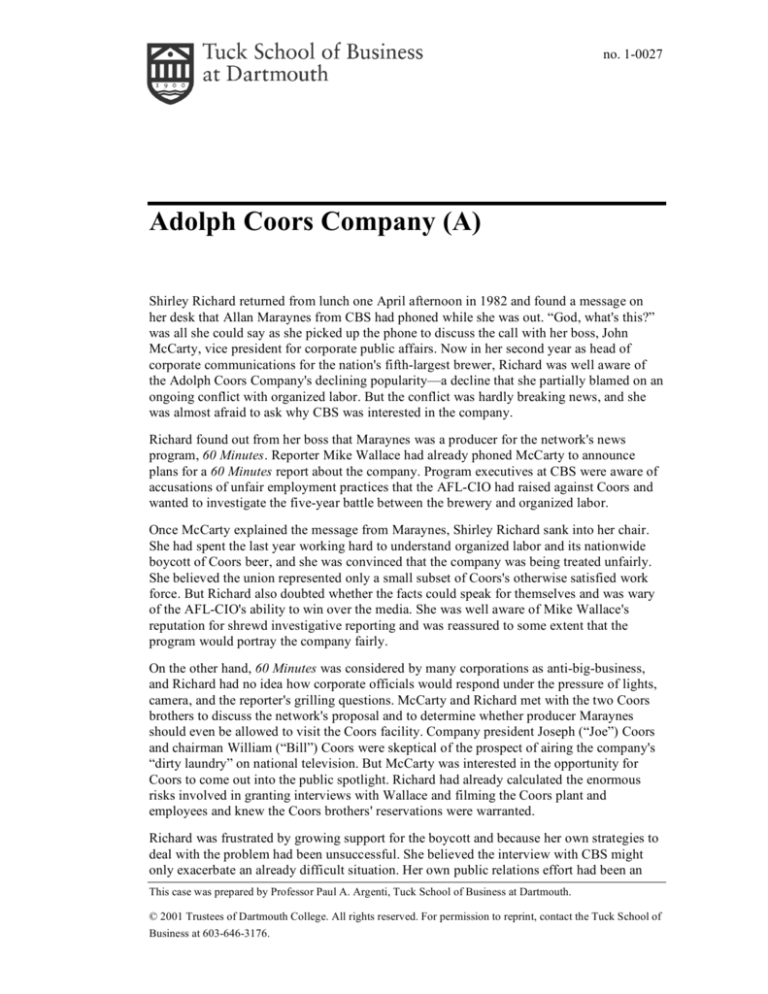
no. 1-0027
Adolph Coors Company (A)
Shirley Richard returned from lunch one April afternoon in 1982 and found a message on
her desk that Allan Maraynes from CBS had phoned while she was out. “God, what's this?”
was all she could say as she picked up the phone to discuss the call with her boss, John
McCarty, vice president for corporate public affairs. Now in her second year as head of
corporate communications for the nation's fifth-largest brewer, Richard was well aware of
the Adolph Coors Company's declining popularity—a decline that she partially blamed on an
ongoing conflict with organized labor. But the conflict was hardly breaking news, and she
was almost afraid to ask why CBS was interested in the company.
Richard found out from her boss that Maraynes was a producer for the network's news
program, 60 Minutes. Reporter Mike Wallace had already phoned McCarty to announce
plans for a 60 Minutes report about the company. Program executives at CBS were aware of
accusations of unfair employment practices that the AFL-CIO had raised against Coors and
wanted to investigate the five-year battle between the brewery and organized labor.
Once McCarty explained the message from Maraynes, Shirley Richard sank into her chair.
She had spent the last year working hard to understand organized labor and its nationwide
boycott of Coors beer, and she was convinced that the company was being treated unfairly.
She believed the union represented only a small subset of Coors's otherwise satisfied work
force. But Richard also doubted whether the facts could speak for themselves and was wary
of the AFL-CIO's ability to win over the media. She was well aware of Mike Wallace's
reputation for shrewd investigative reporting and was reassured to some extent that the
program would portray the company fairly.
On the other hand, 60 Minutes was considered by many corporations as anti-big-business,
and Richard had no idea how corporate officials would respond under the pressure of lights,
camera, and the reporter's grilling questions. McCarty and Richard met with the two Coors
brothers to discuss the network's proposal and to determine whether producer Maraynes
should even be allowed to visit the Coors facility. Company president Joseph (“Joe”) Coors
and chairman William (“Bill”) Coors were skeptical of the prospect of airing the company's
“dirty laundry” on national television. But McCarty was interested in the opportunity for
Coors to come out into the public spotlight. Richard had already calculated the enormous
risks involved in granting interviews with Wallace and filming the Coors plant and
employees and knew the Coors brothers' reservations were warranted.
Richard was frustrated by growing support for the boycott and because her own strategies to
deal with the problem had been unsuccessful. She believed the interview with CBS might
only exacerbate an already difficult situation. Her own public relations effort had been an
This case was prepared by Professor Paul A. Argenti, Tuck School of Business at Dartmouth.
© 2001 Trustees of Dartmouth College. All rights reserved. For permission to reprint, contact the Tuck School of
Business at 603-646-3176.
Adolph Coors Company (A)
no. 1-0027
attempt to portray the circumstances as she believed them to be: good management harassed
by disgruntled labor organizers. She was convinced that her job was not an effort to cover up
Coors's employment practices. “PR doesn't make you into something you're not,” Richard
stated. “You can't whitewash.”
Richard debated how the company should handle the proposal from CBS, realizing that the
communications strategy could seriously affect the corporation's public image. Any
decisions about approaching 60 Minutes would also have to be approved by the Coors
brothers. Richard felt uncertain about how much control she would ultimately have over the
communications strategy. Joe Coors, an ardent conservative and defender of private
enterprise, would undoubtedly resist an open-door policy with the network. At the same
time, Richard wondered if she should attempt to convince the management of this
traditionally closed company to open itself to the scrutiny of a 60 Minutes investigation or
whether the best defense would be a “no comment” approach. But with no comment from
Coors, anything organized labor was willing to say on camera would go uncontested.
History of the Adolph Coors Company
The Coors brewery was established in 1880 by Adolph Coors, a Prussian-born immigrant
who came to the United States in 1868. Having trained as an apprentice in a Prussian
brewery, 22-year-old Adolph Coors became a foreman at the Stenger Brewery in Naperville,
Illinois, in late 1869. By 1872, Coors owned his own bottling company in Denver, Colorado.
With his knowledge of brewing beer and the financial assistance of Joseph Schueler, Coors
established his own brewery in Golden, Colorado. His product was an immediate success. In
1880, Adolph Coors bought out Joseph Schueler and established a tradition of family
ownership that was maintained for almost a century.
The company continued to operate during Prohibition, switching to production of malted
milk. During Prohibition the Coors Company also expanded with the development of new
manufacturing operations. A cement manufacturing facility and a porcelain products plant
were essential to the company's survival during the 17 years of Prohibition. Its brewing
operations flourished again when alcohol was legalized in 1933.
Famous for its exclusive “Rocky Mountain spring water” system of brewing, the Adolph
Coors Company soon became something of a legend in the beer industry. The Coors
philosophy was one of total independence. A broad spectrum of Coors subsidiaries
combined to create a vertically integrated company in which Coors owned and managed
every aspect of production: The Coors Container Manufacturing plant produced aluminum
and glass containers for the beer; Coors Transportation Company provided refrigerated
trucks to haul the beer to its distribution center as well as vehicles to transport coal to fuel
the Golden brewery; Coors Energy Company bought and sold energy and owned the
Keenesburg, Colorado, coal mine which was expected to meet the brewery's coal needs
through the end of the 20th century; the Golden Recycle Company was responsible for
ensuring a supply of raw materials for aluminum can production. By 1980, the recycling
plant was capable of producing over 30 million pounds of recycled aluminum a year. Other
subsidiaries fully owned by Coors included Coors Food Products Company, Coors Porcelain
Company, and the American Center for Occupational Health.
Tuck School of Business at Dartmouth
2
Adolph Coors Company (A)
no. 1-0027
The Coors Mystique
A certain mystique surrounding the Golden, Colorado, brewery and its unique unpasteurized
product won the beer both fame and fortune. Presidents Eisenhower and Ford shuttled Coors
to Washington aboard air force jets. Actors Paul Newman and Clint Eastwood once made it
the exclusive beer on their movie sets. Business magazines lauded Coors as “America's cult
beer.” As Coors expanded its distribution, the mystique appeared irresistible; Coors moved
from 12th to 4th place among all brewers between 1965 and 1969 with virtually no
advertising or marketing.
Part of the Coors mystique was attributed to its family heritage. For over a century of
brewing, company management had remained in the hands of Adolph Coors's direct
descendants. Reign passed first to Adolph Coors, Jr., then to his son William Coors. In 1977,
Bill Coors turned over the presidency to his younger brother Joseph but continued as
chairman and chief executive officer. The company's newest president, Joe Coors, was a
well-known backer of right-wing causes such as the John Birch Society; a founder of a
conservative think-tank, the Heritage Foundation; and a member of President Ronald
Reagan's so-called “Kitchen Cabinet.” The family name was closely associated with strong
conservatism by consumers, labor, and the industry.
The Coors Company was built on a tradition of family and, even after going public in 1975,
remained an organization closed to active public relations. Bill Coors recalled that his father,
Adolph Coors, Jr., was a shy man, and throughout its history the company was reluctant to
attract any public attention. In 1960, the sensational kidnapping and murder of brother
Adolph Coors III focused the public eye on the family and the business, but Coors
maintained a strict “no comment” policy.
The Nature of the Brewing Industry
From the mid-1960s through the 1970s and into the 1980s, the brewing industry was
characterized by a shrinking number of breweries coupled with a growing volume of
production and consumption. In 1963, Standard and Poor's Industry Surveys reported 211
operating breweries. Ten years later that number had dropped to 129, and by 1980 there were
only 100 breweries in operation. On the other hand, per capita consumption of beer rose
from 15 gallons a year in 1963 to 19.8 gallons in 1973. By 1980, per capita consumption had
jumped to 24.3 gallons a year.
Until the mid-1970s beer markets were essentially local and regional, but as the largest
breweries expanded so did their share of the market. Combined, the top five brewers in 1974
accounted for 64 percent of domestic beer production, up from 59 percent in 1973.
Previously strong local and regional breweries were either bought by larger producers or
ceased operations.
A notable exception, however, was the Adolph Coors Company, which dominated the West.
Until 1976, the company's 12.3 million-barrel shipment volume was distributed only in
California, Texas, and 10 other western states. Coors's share of the California market alone
was well over 50 percent in 1976. Coors dominated its limited distribution area, capturing at
least 35 percent of the market wherever it was sold statewide. The Coors Company ranked
Tuck School of Business at Dartmouth
3
Adolph Coors Company (A)
no. 1-0027
fifth in market share throughout the 1970s trailing giants Anheuser-Busch, Joseph Schlitz,
Phillip Morris's Miller, and Pabst, all of which had much broader distribution areas.
Competition for market share among the top five brewers was intense during the 1970s and
led producers to more aggressive attempts to win consumers. According to compilations by
Leading National Advertisers, Inc., advertising expenditures for the first nine months of
1979 were up 37 percent from the previous year for Anheuser-Busch, 18 percent for Miller,
14 percent for both Schlitz and Pabst, and 78 percent for Adolph Coors.
Marketing and Distribution at Coors
Industry analysts criticized the Coors Company's sales strategy for stubbornly relying on its
product's quality and image rather than marketing. In 1976, the Coors mystique appeared to
be losing its appeal to strong competitors--for the first time since Prohibition, Coors could
not sell all of its beer. The company finally responded to competition by intensifying its
marketing and development operations. Between 1976 and 1981, the company attempted to
revive sales by adding eight new states to its distribution. In May of 1978, Coors began to
market its first new product in 20 years: Coors Light. In 1979, Coors began the first major
advertising campaign in its history to defend itself against aggressive competitors such as
Phillip Morris's Miller Brewing Company and Anheuser-Busch. The company's 1981 annual
report pictured Coors's newest product—George Killian's Irish Red Ale—along with a newly
expanded package variety designed to “keep pace with consumer demand.”
The Coors Company went public in 1975, but investors did not fare well as stock prices
declined for the rest of the decade. Coors entered the market at a share price of $31 but by
1978 had fallen to $16—a loss of about 50 percent for the first public stockholders. Net
income, according to the company's annual report, was $51,970,000 in 1981, or $1.48 per
share. That figure reflected a 20 percent drop from $64,977,000, or $1.86 per share, in 1980.
Management-Labor Relations at Coors
During pre-Prohibition years, breweries, including Coors, were entirely unionized. In 1914,
the first vertically integrated industrial union in the country established itself at Coors. When
the country went dry, Coors remained viable through alternative operations, but the
workforce still had to be reduced. Coors offered older workers employment but fired
younger employees. A strike of union employees resulted and remained in effect until 1933
when Prohibition was repealed. The company, however, continued to operate without a
union until 1937 when Adolph Coors, Jr., invited the United Brewery Workers International
(UBW) into the Coors Company.
In 1953, the company experienced an abortive strike by the UBW to which a frightened
management immediately gave in. In 1955, Coors's organized porcelain workers struck
because their wages were less than those of brewery workers. Although the plant continued
to operate, all of Coors's unionized workers engaged in a violent strike that lasted almost
four months. The union ultimately lost the battle 117 days after the strike, when workers
returned to the plant on company terms.
Tuck School of Business at Dartmouth
4
Adolph Coors Company (A)
no. 1-0027
Negotiations over a new union contract in 1957 ended in a stalemate between labor and
management, and workers again decided to strike. For another four months, workers were
torn between paternalistic and small-town personal ties to management and the demands of
the union. Bill Coors, who was then the plant manager, recalled that during the strike,
management had wanted to show the union it was not dependent on union workers. Coors
hired college students during the summer of 1957 as temporary replacements for the striking
brewers. When the students left, the picketers were threatened by management's vow to hire
permanent replacements and returned to the plant. The strike was a clear defeat of the
union's demands and ultimately left international union leaders with an unresolved bitterness
toward Coors. Back in full operation by the fall of 1957, Coors management believed it had
won complete control.
By the end of the 1950s, 15 local unions were organized at Coors. Management tolerated the
unions, but claimed they did not affect wages or employment practices. The Coors family
firmly believed that good management removed the need for union protection and that
management could win workers' loyalty. In 1960, the plant's organized electricians went on
strike but failed to garner the support of other unions, and the plant continued to operate with
nonunion electricians hired to replace the strikers. Similar incidents occurred with Coors's
other unions. A 1968 strike by building and construction workers ended with Coors breaking
up 14 unions. By 1970, Coors's workforce was predominantly nonunion.
A contract dispute between Coors's management and UBW Local 366 erupted in 1976.
Workers demanded a 10 percent wage increase and better retirement benefits. After more
than a year of negotiations, union officials rejected management's compromise offer, which
labor contended would erode workers' rights. In April of 1977, over 94 percent of UBW
workers voted to strike. Production at the plant continued at 70 percent of normal capacity,
however, and management boldly announced plans to replace striking workers. In defense of
the union, AFL-CIO officials declared a nationwide boycott of the beer until a new contract
settlement was reached. But within five days of initiating the strike, 39 percent of the union
members crossed the picket lines to return to work.
In 1978, Coors management called an election for decertification of UBW Local 366.
Because more than a year had passed since the strike began, National Labor Relations
regulations restricted striking union members from voting. Only workers remaining at the
plant, including “scabs” hired across the picket lines, could vote on whether to maintain the
UBW Local. In December of that year, Coors employees voted a resounding 71 percent in
favor of decertifying the Local UBW.
Since 1957, the Coors brewery had been a “closed shop,” in which workers were required to
pay union dues if they were to benefit from union action. But company officials called the
1978 decertification vote a victory for the “open shop,” wherein workers could enjoy union
benefits without paying dues as members. Union officials, frustrated over the lack of a new
contract and the decertification vote, publicly charged Coors with “union busting.”
In fact, according to AFL-CIO officials, the UBW was the 20th Coors union decertified
since the mid-1960s. Management consistently argued that employees simply rejected union
organization because they didn't require it; good management eliminated the need for a
union to protect workers. But organized labor maintained that all 20 unions had been
“busted” by votes called while members were on strike and scabs were casting the ballots.
Tuck School of Business at Dartmouth
5
Adolph Coors Company (A)
no. 1-0027
By the end of the decade, only one union representing a small group of employees remained
active at Coors.
Nationwide Boycott
The AFL-CIO was determined not to be defeated by the ousting of the UBW Local from the
Golden plant. In defense of the union, AFL-CIO officials declared a nationwide boycott of
Coors beer until a new contract settlement could be reached and soon began to claim that
their efforts had a significant effect on sales. In fact, 1978 figures reported a 12 percent
profit decline for the brewery during fiscal 1977 and predicted that 1978 figures would fall
even lower. Corporate officials conceded the boycott was one factor influencing declining
sales but refused to admit the drop was consistent or significant.
The defeat of the Coors local brewers' union fueled the boycott fire, but the protest focused
on issues beyond the single contract dispute begun in 1977. The other issues of protest
related to Coors's hiring practices. Labor leaders claimed that a mandatory polygraph test
administered to all prospective employees asked irrelevant and personal questions and
violated workers' rights. In addition, the protesters claimed that Coors discriminated against
women and ethnic minorities in hiring and promotion. Finally, boycotters argued that Coors
periodically conducted searches of employees and their personal property for suspected drug
use and that such search and seizure also violated workers' rights. The boycott galvanized
organized labor as well as minority interest groups that protested in defense of blacks,
Hispanics, women, and gays.
The boycott's actual effect on sales was the subject of dispute. Coors's sales had begun to fall
by July 1977, just three months after the boycott was initiated. Some analysts attributed the
drop not to protesting consumers, but rather to stepped-up competition from AnheuserBusch, which had begun to invade Coors's western territories. Despite a decline, Coors
remained the number-one seller in 10 of the 14 states in which it was sold. Labor, on the
other hand, took credit for a victory at the end of 1977 when Coors's fourth-quarter reports
were less than half of sales of the previous year for the same period. Dropping from $17
million in 1976 to $8.4 million in 1977, Coors was faced with a growing challenge. There
was no doubt that management took the AFL-CIO protest seriously and began attempts to
counter declining sales through more aggressive advertising and public relations.
Federal Lawsuit
The AFL-CIO boycott gained additional legitimacy from the federal government. In 1975,
the federal Equal Employment Opportunity Commission had filed a lawsuit against Coors
for discrimination in hiring and promotion against blacks, Mexican Americans, and women.
The suit charged Coors with violating the 1964 Civil Rights Act and challenged Coors's
hiring tests, which the EEOC said were aimed at revealing an applicant's arrest record,
economic status, and physical characteristics. The lawsuit stated that the company used
“methods of recruitment which served to perpetuate the company's nonminority male
workforce.”
Tuck School of Business at Dartmouth
6
Adolph Coors Company (A)
no. 1-0027
In May of 1977, one month after the initiation of the AFL-CIO boycott, Coors signed an
agreement with the EEOC, vowing that the brewery would not discriminate in hiring. But
according to media reports, Coors still refused to admit any past bias toward blacks,
Mexican Americans, and women. Coors said it would continue a program begun in 1972
designed to increase the number of women and minorities in all major job classifications.
Striking brewery workers refused to sign the agreement, although the Coors's Operating
Engineers Union entered into the agreement.
David Sickler and the AFL-CIO
The principal organizer of the AFL-CIO boycott against the Adolph Coors Company was the
former president of the company’s Local UBW. David Sickler had been employed by Coors
for 10 years, acting as a business manager from 1973-1976. Sickler left the plant in 1976 to
take a job with the AFL-CIO in Montana. In April of 1977, the AFL-CIO decided to put
Sickler in charge of coordinating the national boycott against Coors. Sickler moved to Los
Angeles where he also served as director of the Los Angeles organizing committee and the
subregional office of the AFL-CIO.
Sickler initially resisted the AFL-CIO's request to put him in charge of organizing the
boycott. He believed that his past employment at the company made him too close to the
situation to offer a fair position on the issues at stake. But the AFL-CIO felt that Sickler's
tenure with Coors made him an ideal choice; according to Sickler, his personal reports of
abuse by the company in hiring and employment practices were shared by numerous Coors
employees and were the central issues of the boycott.
Sickler contended that when hired by Coors, he had been subjected to questions on a lie
detector test regarding his personal life and sexual preference. In addition, he reported the
company's practice of searching individuals or entire departments for suspected drug use.
Despite corporate officials' insistence that the accusations were false, Sickler was convinced
that Coors employees were generally “unhappy, demoralized.”
Coors management was determined to fight back against the boycott, and filed a breach of
contract suit against the Local 366. The company charged that any boycott was prohibited
under contract agreements. Management also made clear to the public its outrage over the
boycott, as chairman Bill Coors began to speak out in the national media. In a 1978
interview with Forbes magazine, Coors stated about the AFL-CIO: “No lie is too great to tell
if it accomplishes their boycott as a monument to immorality and dishonesty.” Earlier that
year, Bill Coors defended the company against charges of being antiunion. A New York
Times report on the dispute quoted the CEO as saying: “Our fight is not with Brewery
Workers Local 366. Our fight is with organized labor. Three sixty-six is a pawn for the AFLCIO; that's where they're getting their money.”
Corporate Communications at Coors
The 1977 boycott forced company officials to re-examine the area of corporate
communications. Because labor leaders set out to “destroy the company,” Bill Coors, now
chairman and chief executive officer of the company, believed management must relate its
Tuck School of Business at Dartmouth
7
Adolph Coors Company (A)
no. 1-0027
side of the story. “There was no lie they wouldn't tell,” the CEO recalled. “No one knew
about Coors, and we had no choice but to tell the story.”
In 1978, John McCarty, a fund-raiser at Pepperdine University, was hired as the vice
president for corporate public affairs. McCarty brought to Coors expertise in minority
relations and set out to repair the company's damaged reputation among minority groups.
McCarty established a staff of corporate communications officers. The division was
organized into four branches under McCarty's leadership: corporate communications,
community affairs, economics affairs, and legislative affairs.
In response to the boycott and declining sales, McCarty enlisted the expertise of J. Walter
Thompson's San Francisco office to help the company improve its corporate image. Coors
launched what analysts termed a strong “image building” campaign in 1979, with messages
aimed at ethnic minorities, women, union members, and homosexuals. The theme
throughout the late 1970s was clearly a response to labor's accusations against the company:
“At Coors, people make the difference.”
Another component of the new image campaign, according to media reports, was to
condition company managers to project charm and humility in dealing with reporters. Coors
executives participated in a training course designed to help them overcome a traditional
distrust of the media.
Shirley Richard
Shirley Richard was hired along with McCarty in 1978 to direct the company's legislative
affairs branch but was familiar with the Coors Company long before joining its staff. From
1974-1978, Richard worked on the Coors account as a tax manager for Price Waterhouse.
One important issue for the Coors account, Richard recalled, was the deductibility of
lobbying expenses and charitable donations. As part of her job, Richard became involved in
the political arena, helping Coors set up political action committees. When Richard decided
to leave Price Waterhouse in 1978, she asked Coors's vice president of finance for a job and
was hired to head the legislative affairs department, a position she held until 1981.
Richard recalled her first year with the company as a time when Coors was “coming out of
its shell”; Phillip Morris's purchase of Miller Brewing Company meant increased
competition for Coors and a demand for more aggressive advertising. In 1975, the company
sold its first public stock. The bad publicity from the 1977 strike and its aftermath combined
with greater competition led to a serious decline in sales and disappointed shareholders.
Clearly, the Coors mystique alone could no longer speak for itself, and an aggressive public
relations campaign was unavoidable.
One year before the 60 Minutes broadcast of the Coors story, Richard became Adolph Coors
Company's director of corporate communications. In that position, she managed 25 people,
covering corporate advertising, internal communications, distribution communications,
training programs, and public relations personnel.
Tuck School of Business at Dartmouth
8
Adolph Coors Company (A)
no. 1-0027
Confrontational Journalism
The challenge of CBS's 60 Minutes to any company under its investigation was formidable.
The 14-year-old program was consistently ranked in Neilsen ratings' top 10 programs
throughout the 1970s. Media critics offered various explanations for the success of this
unique program, which remarkably combined high quality with high ratings. A New York
Times critic summarized the sentiment of many within the broadcast profession when he
called 60 Minutes, “without question, the most influential news program in the history of the
media.”
The program had earned its popularity through consistently hard-hitting, investigative
reporting. Executive Producer Don Hewitt proclaimed 60 Minutes the “public watchdogs.”
In his book about the program, Hewitt recalled, “I became more and more convinced that a
new type of personal journalism was called for. CBS Reports, NBC White Papers, and ABC
Closeups seemed to me to be the voice of the corporation, and I didn't believe people were
any more interested in hearing from a corporation than they were in watching a
documentary.” Stories revealing insurance executives taking advantage of the poor with
overpriced premiums, companies polluting streams and farmlands by irresponsibly dumping,
or physicians gleaning profits from unnecessary surgery had all worked to rally public
support and faith in CBS as a sort of consumer protection agency.
The program's success in uncovering scandal was due in large part to the aggressive and
innovative technique of Mike Wallace. Wallace had been with the program throughout its
history and was responsible for shaping much of the 60 Minutes image. His reporting was
always tough, sometimes theatrical, and was commonly referred to within the media as
“confrontational journalism.” Wallace had a reputation in broadcast circles and among 60
Minutes viewers for making the sharpest executives and politicians crumble.
But the program was not flawless. Hewitt admitted he had made mistakes, and one of the
most glaring cases against 60 Minutes was a story about the Illinois Power Company. In
November of 1979, 60 Minutes broadcast a story about cost overruns at a Clinton, Illinois,
nuclear power plant, a story that included some obtrusive inaccuracies. Illinois Power was
not to be victimized by 60 Minutes and produced a videotape about the program, portraying
it as antibusiness and antinuclear. Hewitt admitted that the company's defense had worked.
“Five years after Illinois Power took us over the coals for that story, the plant is now seven
years behind schedule and more than two and a half billion over budget. Have we reported
that? I'm afraid not. You see, their beanball worked.”
Allan Maraynes was assigned to produce the Coors segment. His experience with 60
Minutes was highlighted by some significant clashes with big business. He had produced
stories on the Ford Pinto gasoline tank defects, Firestone tires, I. Magnin, and SmithKline.
Maraynes was alerted to the Coors controversy when 60 Minutes researchers in San
Francisco told him they suspected bad things were happening at Coors. The research group
told Maraynes that the AFL-CIO was calling Coors a “fascist organization,” which sounded
to the producer like good material for a story.
Maraynes first flew to California to interview David Sickler. “We said we were setting about
to do a story explaining that a fascist state exists at Coors,” Maraynes recalled about his
conversation with Sickler. “If it's true, we'll do it.” Maraynes wanted Sickler to give him as
Tuck School of Business at Dartmouth
9
Adolph Coors Company (A)
no. 1-0027
much information about the boycott as he had. Maraynes wanted the angle of the story to be
a focus on case histories of the people who had experienced Coors's unfair treatment.
April 1982
With the phone call from Maraynes, all of the pressures from David Sickler, the AFL-CIO,
and the boycott were suddenly intensified. Shirley Richard had worked hard in the last year
to focus public attention away from the boycott, but now her efforts to project a positive
corporate image were threatened. Thinking ahead to the next few months of preparation
time, she felt enormous pressure in the face of such potentially damaging public exposure.
Shirley Richard was not naive about Mike Wallace or the power of television news to shape
a story and the public's opinion. Richard, along with other Coors executives, believed that
the company was not at fault, but that did nothing to guarantee that its story would be
accurately portrayed in a 60 Minutes report. Mike Wallace himself had voiced the reason for
a potential subject to fear the program's investigative report. In an interview with The New
York Times, Wallace stated: “You (the network) have the power to convey any picture you
want.”
Richard knew that a big corporation's abuse of employees was just the kind of story 60
Minutes was built on, and she didn't want Coors to be part of enhancing that reputation,
especially when she believed organized labor had fabricated the controversy about Coors.
Given Mike Wallace's desire to get the story, Shirley Richard guessed the company would
automatically be on the defensive.
It was clear that 60 Minutes was determined to do the story, with or without cooperation
from Coors. Richard wondered, however, whether an interview with Mike Wallace would do
the company more harm than good. On the other hand, she considered the possibility that the
company could somehow secure the offensive and turn the broadcast into a final clarification
of Coors's side of the boycott story.
Richard was clearly challenged by an aggressive news team, and she was uncertain about
cooperation from the conservative Coors brothers. Even if she could convince them that an
open door was the best policy, would corporate officials be able to effectively present the
facts supporting Coors's position? The national broadcast would reach millions of beer
drinkers, and Richard knew that the 60 Minutes report could either make or break the future
success of Coors beer.
Case Questions
1) Should Shirley Richard encourage or discourage the Coors brothers to go on 60
Minutes?
2) What kind of research should she do?
3) What would her communication objective be if Coors agreed to the interview? If they
did not do the interview?
Tuck School of Business at Dartmouth
10
Adolph Coors Company (A)
no. 1-0027
4) What suggestions would you have for improving the corporate communications function
at Coors?
5) What other problems should Richard focus on?
Tuck School of Business at Dartmouth
11

